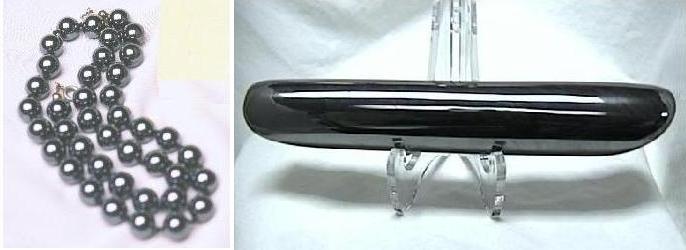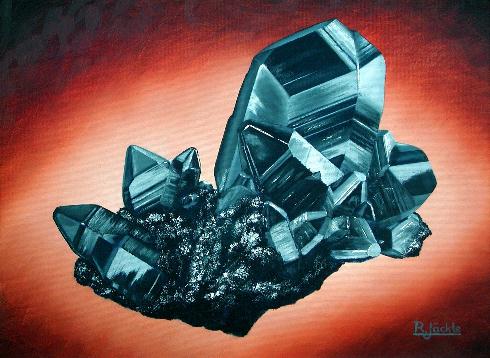(
Fr- hématite; Ger- Hämatit/Roteisenstein;
Nor- hematit; Rus-![]() )
)
HEMATITE (also spelled haematite), Fe2O3

A. Hematite. Round beads (diameters - 1 cm). F.S. Dietrich collection. (photo by D.R. Fisher)
B. Hematite. Double-end
massage wand (length - ca.
12.5 cm ). (© photo courtesy www.wehug.com)

D. Hematite. Crystal group (greatest dimension - 3.5 cm) from N'Chwaning II mine, Kalahari Manganese Field, South Africa: oil painting (40 x 54 cm) by Rainer Jäckle, owner of the specimen. (© photo by R. Jäckle)
DESCRIPTION: Lustrous botryoidal or
stalactitic masses, frequently called "kidney iron ore," and individual
crystals of the hematite variety, commonly called specular hematite or specularite, are
used as the rough material for fashioning gemstones and ornamental
pieces. The former material is a gemrock (see Figure C), the latter is
in essence a
gem mineral (see Figure D). The following properties obtain for
both materials:
Color - steel gray to nearly black
H. 5-6½
S.G. ~ 5.25
Light transmission - opaque
Luster - dull to highly lustrous -- i.e.,
submetallic; polished surfaces are brilliant.
Miscellany - streak (color of powder)
-- red; soluble in acid.
A second "new type of haematite" also used as a gemrock has been described by Schmetzer and Bank (1984) as a granular material consisting largely of hematite plus minor amounts of magnetite, martite and gangue minerals. This granular material is described as typically bluish gray, having a dark brown streak, and magnetic, and that polished surfaces of it tend to be slightly pitted.
OTHER NAMES: In addition to the below-listed terms, which are applied to hematite or hematite-rich gemrocks, several other gemrocks and a few gem minerals owe their red color and or other desirable characteristics to the presence of hematite, and thus warrant mentioning here. Examples include the following: hemachate (haemachates) -- see CHALCEDONY entry; red jasper -- see JASPER entry; rubasse (rubace, rubacelle) - see Appendix A; sunstone - a hematite-bearing feldspar (oligoclase) gemstone; tiger iron -- see HAWK'S-EYE...entry.
OCCURRENCES: Hematite used as a gemrock occurs as microcrystalline masses comprising nodules, etc.; the granular "new ... haematite" occurs like many hematite ores.
NOTEWORTHY LOCALITIES: Cumbria (in part formerly Cumberland), England; here and there in Germany, Norway, Sweden, Morocco, Canada and New Zealand; the island of Elba; Black Widow mine, Pima County, Arizona; Lake Superior district of Minnesota, Wisconsin and Michigan. The granular "new ... haematite" has been recorded as occurring in the Quadrila'tero Ferrifero area near Ouro Preto, Minas Gerais, Brazil.
REMARKS: Theophrastus' “On Stones” (~315 B.C.) is the earliest known reference to what is thought now to have been hematite; his name for the material, which translates to bloodstone, was apparently based on the fact that its red powder indicated it possibly represented coagulated blood. Some four hundred years later, Pliny, the Elder (pre-79 A.D, Book xxxvii) used hæmatites, the Latin equivalent, in his widely cited Historia Naturalis. The varietal name specularite (and the adjective specular) come from the Latin word for mirror, apparently reflecting (no pun intended) that use of highly lustrous black hematite.
The redness of hematite powder was an early recognized characteristic and, in ancient times, this property led to its being fashioned into amulets used to ward off or stop bleeding. Later, according to Pliny, the Elder (op cit.), hematite was described in volumes about precious stones written by Zachalias of Babylon and dedicated to Mithridates the Great, King of Pontus (d.63 B.C.) as having all sorts of attributes -- e.g., curing diseases of the eyes and liver, aiding those in battle, and even helping petitioners in trials. Ancient and present day Havasupai people of the Grand Canyon of the Colorado region use a hematite-rich paste-like mixture as a snake repellent.
Some people consider small hematite spheres to constitute an excellent substitution for black pearls. As already mentioned, however, apparently at least some of those who wear them find strings of hematite beads too heavy to wear comfortably except for short periods of time.
The following is recorded on the web site www.beringseaoriginals.com: “Hematite has long since been part of our heritage here in Alaska and Russia since the early days before Alaska was purchased by the United States. Lord Baranof once had skilled Aleut Silversmiths make hematite into rings and pendants. [and] This beautiful Black Diamond [-- as already noted, the name often applied to hematite, particularly in Alaska --] was presented to the Royal Family of Czar Alexander I as a Royal gift from his Alaskan Subjects to show their faithfulness to the Great Czar.”
Hematite (though not as a gemrock) is the state mineral of Alabama.
SIMULANTS:
***Barium iron oxide (synthetic BaFe12O19) - material constituting bracelets said to have been made in China and sold "all over Europe as hematite" was determined to have this composition (E. Fritsch in Johnson et al., 2000). - [This material is highly magnetic whereas typical hematite is not and even some atypically magnetic hematite is only slightly magnetic.].
Black pearl - potential, but why? -- the opposite (i.e., hematite as a simulant for black pearls) makes a lot more sense. - [inferior specific gravity].
Cut steel - steel, usually "cut" to give it several facets, was used – especially during the late 1700s – for such diverse things as shoe buckles, hair ornaments and jewelry. Subsequently, especially during the 1800s, steel with a similar appearance was fashioned by stamping, rather than cutting, and used for the same general purposes. - [For pieces that resemble hematite, the fact that the steel that was used is strongly magnetic suffices to distinguish it from hematite.]
***Glass - [conchoidal fracture; specific gravity less than half that of hematite].
***Hemalyke - name given to what amounts to restructured/reconstructed hematite -- i.e., it consists of ground up hematite plus some binder that is pressed and then molded or faceted into items commonly fashioned from natural hematite. - [Distinquishing this material from natural hematite often requires non-macroscopic observations.].
***Hematite garnet - material reportedly synthesized in Zimbabwe - [lower specific gravity (S.G. ~4.16)].
***Hemetine - trade name given a hematite simulant used widely for intaglios, at least some of which have been produced by stamping rather than carving. According to the "Dictionary of gems and gemology ... " (GIA, 1974), "The raw material [originally] used ... was galena ..., resulting in a black streak and a heavy specific gravity.... [But.] more recent material contains mainly iron and titanium oxides, resulting in a red-brown streak and nearly the same specific gravity ... and hardness ... as hematite." Stainless steel has also been recorded as a major constituent of some hemetine. - [In addition to the just mentioned differences, at least some hemetine is strongly magnetic.].
Magnetite (including lodestone) - rarely fashioned into gemstones that resemble hematite - [Magnetite is strongly magnetic whereas hematite is at most weakly magnetic.].
Psilomelane - sometimes marketed as hematite - [Luster appears more satinlike and streak (color of powder) is brown whereas that of hematite is red.].
"Scientific hematite" - name given to "a white metal ... found to be a typical stainless steel composed principally of iron and chromium with small amount of nickel ... [with its] intaglio design ... stamped into the metal ... [and marketed as stones in ] a series of 'inexpensive rings' " (Anonymous report of American Gemological Society Research Service in "Gems & Gemology" III:112). - [Appearance suffices -- does not really look like hematite.].
Synthetic hematite - a flux grown hematite is recorded by Liddicoat (1967). - [ I suspect non-macroscopic means would be required.].
REFERENCES: No good general reference, but see Jones (1989).
R. V. Dietrich © 2015
Last
update: 27 January 2014
web page created by Emmett Mason